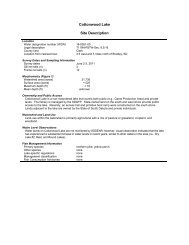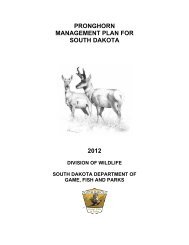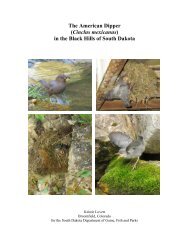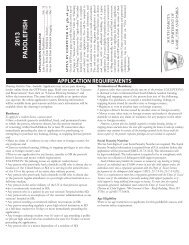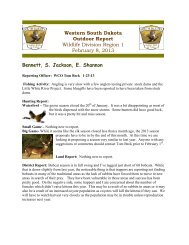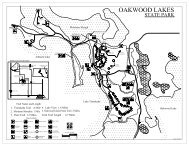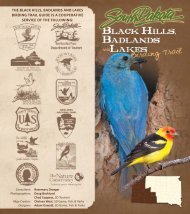pdf version - South Dakota Department of Game, Fish and Parks
pdf version - South Dakota Department of Game, Fish and Parks
pdf version - South Dakota Department of Game, Fish and Parks
Create successful ePaper yourself
Turn your PDF publications into a flip-book with our unique Google optimized e-Paper software.
Common Shiner<br />
Luxilus cornutus<br />
Quick key characteristics: The common shiner is found in cool-water<br />
habitats. It has large, diamond-shaped, silvery scales that are taller than wide<br />
along the front portion <strong>of</strong> the lateral line <strong>and</strong> deciduous. Dark scales are<br />
scattered along the sides. Fins are s<strong>of</strong>t with short bases. It has a forwardfacing<br />
mouth <strong>and</strong> pointed snout <strong>and</strong> its body is taller than wide.<br />
Similar species in <strong>South</strong> <strong>Dakota</strong>: other minnows<br />
Identifi cation: The combination <strong>of</strong> (1) tall, deciduous scales along the front<br />
portion <strong>of</strong> the lateral line, (2) a relatively deep body, <strong>and</strong> (3) relatively large<br />
eyes distinguishes the common shiner from similar fi shes in <strong>South</strong> <strong>Dakota</strong>.<br />
Range: The common shiner is native to the Great Lakes, northern Mississippi<br />
River, <strong>and</strong> Red River <strong>of</strong> the North basins. In <strong>South</strong> <strong>Dakota</strong>, it is most common<br />
in eastern streams, but may have historically occurred in spring-fed western<br />
streams as well.<br />
Items <strong>of</strong> interest:<br />
• Often present in multi-species schools<br />
• Feeds primarily on insects <strong>and</strong> crustaceans<br />
• Breeding males grow large tubercles on top <strong>of</strong> the head, on the snout,<br />
<strong>and</strong> in a single row along the edge <strong>of</strong> the lower jaw<br />
• Males <strong>of</strong>ten build spawning pits in<br />
gravel for females to deposit eggs<br />
• Many males may occupy a nest,<br />
which results in frequent fi ghts<br />
• Can exceed 8 in<br />
22






